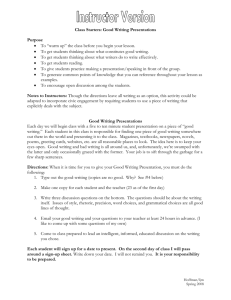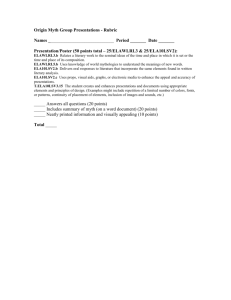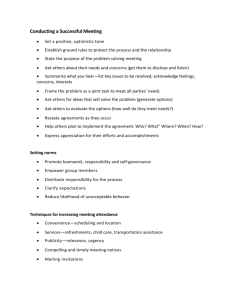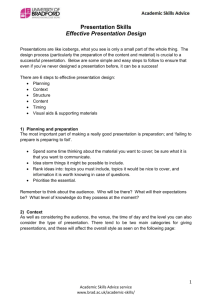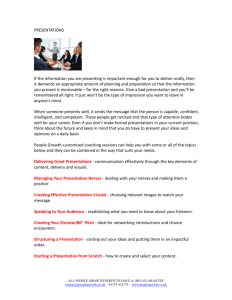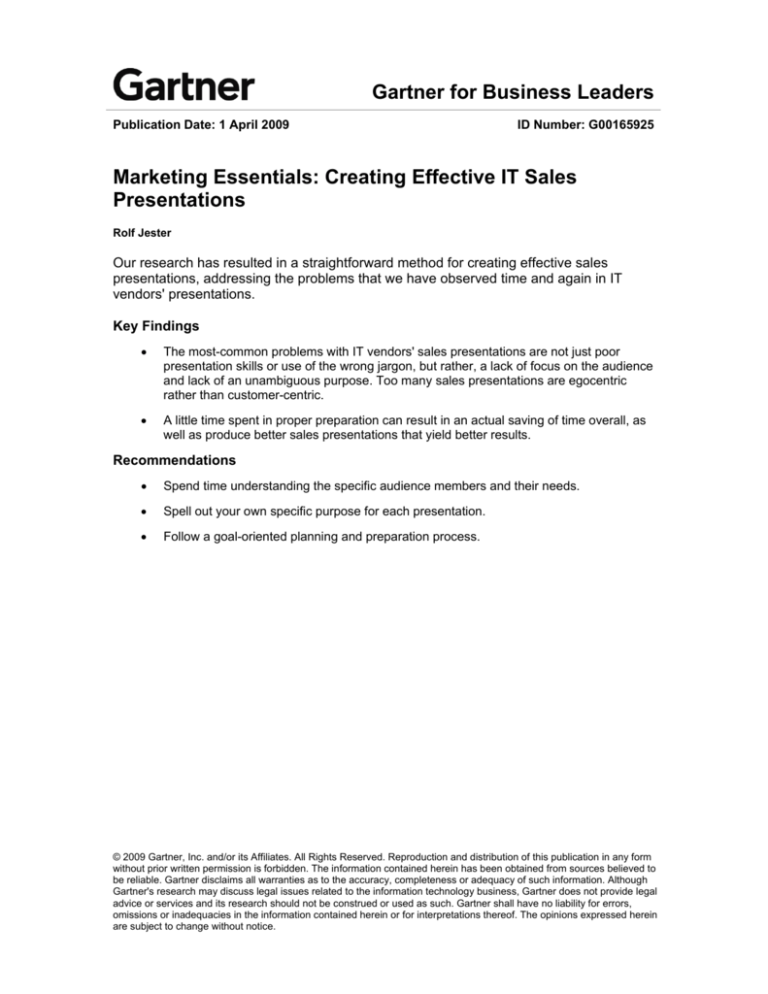
Gartner for Business Leaders
Publication Date: 1 April 2009
ID Number: G00165925
Marketing Essentials: Creating Effective IT Sales
Presentations
Rolf Jester
Our research has resulted in a straightforward method for creating effective sales
presentations, addressing the problems that we have observed time and again in IT
vendors' presentations.
Key Findings
•
The most-common problems with IT vendors' sales presentations are not just poor
presentation skills or use of the wrong jargon, but rather, a lack of focus on the audience
and lack of an unambiguous purpose. Too many sales presentations are egocentric
rather than customer-centric.
•
A little time spent in proper preparation can result in an actual saving of time overall, as
well as produce better sales presentations that yield better results.
Recommendations
•
Spend time understanding the specific audience members and their needs.
•
Spell out your own specific purpose for each presentation.
•
Follow a goal-oriented planning and preparation process.
© 2009 Gartner, Inc. and/or its Affiliates. All Rights Reserved. Reproduction and distribution of this publication in any form
without prior written permission is forbidden. The information contained herein has been obtained from sources believed to
be reliable. Gartner disclaims all warranties as to the accuracy, completeness or adequacy of such information. Although
Gartner's research may discuss legal issues related to the information technology business, Gartner does not provide legal
advice or services and its research should not be construed or used as such. Gartner shall have no liability for errors,
omissions or inadequacies in the information contained herein or for interpretations thereof. The opinions expressed herein
are subject to change without notice.
TABLE OF CONTENTS
Analysis ............................................................................................................................................. 3
1.0 Introduction..................................................................................................................... 3
2.0 Background and Context ................................................................................................ 3
3.0 Best Practice .................................................................................................................. 4
3.1 Start With the Audience..................................................................................... 4
3.2 Set a Clear Purpose .......................................................................................... 5
3.3 Use a Goal-Oriented Process ........................................................................... 6
3.4 Check the Result ............................................................................................... 8
4.0 Conclusions .................................................................................................................... 9
Recommended Reading.................................................................................................................... 9
LIST OF TABLES
Table 1. Example of Goal-Oriented Plan........................................................................................... 7
LIST OF FIGURES
Figure 1. Visualizing the Sales Presentation Process....................................................................... 6
Publication Date: 1 April 2009/ID Number: G00165925
© 2009 Gartner, Inc. and/or its Affiliates. All Rights Reserved.
Page 2 of 10
ANALYSIS
1.0 Introduction
Marketing and sales executives often find themselves creating sales presentations for their own
or others' use. They also coach less-experienced people on how to create and deliver such
presentations. Of course, this should be easy: Who better than you knows the benefits of your
offering and why customers need the solution you are selling? You "only" have to help the
audience visualize themselves enjoying the net benefits of that solution, and steer them toward a
buy decision. Our research, however, shows that in the IT and communications industry, the
effectiveness of these presentations is far less than it should be. And presenters know it and
actually admit it to the customers: We often hear presenters apologizing for their material.
Thus, time is spent less effectively than it should be, by the presentation creators and presenters;
consequently, the audience — the customers or prospects — waste time, too, and do not see
what they need to see to make a decision expeditiously.
Our purpose in this document is to help IT marketing and sales executives create more-effective
sales presentations that advance a sales opportunity toward a positive outcome. We describe a
proven process for creating effective sales presentations.
This research is about sales presentations; it is not about seminar presentations, whereby you
present case studies or thought leadership material. Those are different types of presentations
with a different set of challenges, although parts of the communications process are the same,
and therefore, the method described here can be adapted.
Also, this research is not about briefings for analysts, who are a different audience.
We are not offering advice here about the delivery of sales pitches, speech techniques and stage
craft, which are all different topics. We are not covering techniques for using presentation
software, such as Microsoft's PowerPoint. There are techniques for that, but poor use of tools is
not the primary problem with IT vendor sales presentations.
2.0 Background and Context
In 2006, Gartner published "How to Improve Sales Presentations," which described numerous
bad practices. In fact, it described some actual cases that were so bad, they were hard to believe,
although absolutely true. In this document, we focus on good practices and a repeatable process
for getting it right.
The kinds of presentations we include here are those that are specific to a particular sales
situation, aimed to advance a particular opportunity to its next stage. The next stage could be
anything from taking the first step to discuss an opportunity through to signing an order. We
believe that helping vendors create that type of presentation is one of the most urgent needs right
now in the current market environment. The principles of the method can be applied to the "catchall" general corporate presentations, but a diverse and less-well-known audience presents
different challenges, and that situation is not the subject of this document.
Our recommendations are based on the following research:
•
Many decades of critical observation of sales presentations, as analysts, customers,
consultants and vendors, on both "sides" of the presentation, and as coaches.
Publication Date: 1 April 2009/ID Number: G00165925
© 2009 Gartner, Inc. and/or its Affiliates. All Rights Reserved.
Page 3 of 10
•
Formal analysis and critique of actual presentations as part of the review of marketing
communications material, which we do routinely for our vendor clients.
•
Feedback gathered from analysts as part of the 2006 research, showing the common
faults with sales presentations.
•
Learning from our own individual experiences in creating and delivering sales
presentations: concluding what worked and what didn't.
•
Formal training in crafting presentations of all kinds, including good sales
communication principles, and good communications principles, in general.
This approach is not just theory — it works. We have used it over extended periods of time.
Although busy marketing and sales executives often tend to avoid such a structured approach
when the pressure is on, in fact it saves time.
All our research and experience have shown that the primary problems with IT vendors' sales
presentations are as follows.
•
Presenters pay insufficient attention to understanding the specific audience and its
needs. They are egocentric, not customer-centric. This is the root cause of the frequent
use of the wrong jargon by IT sales and support people.
•
Presenters are not clear, even in their own minds, about the specific purpose they are
trying to achieve. It is little wonder if they do not achieve anything.
•
Lack of a plan and lack of a clear process for preparing the presentations result in the
inclusion of too much irrelevant content, which is often just standard boilerplate material.
Audiences have been totally immunized against standard IT sales boilerplate material.
They no longer pay attention to it.
•
There is not always a clear call to action.
We address these problems in the Best Practice section.
3.0 Best Practice
Some parts of these best practices sound obvious, or are just common sense, and that is true;
they are. But they are all too often ignored in practice. The vendors whose executives use them
will regain an advantage.
3.1 Start With the Audience
All marketing, and therefore all sales, starts and ends with a customer. All good communication
starts with a clear understanding of the audience. Empathy with the audience is even better, and
it leads to great presentation technique, but that is beyond our scope in this document. Starting
with the audience is the essence of being customer-centric, as opposed to egocentric. For more
information, see "Dataquest Insight: Is Your Messaging Customer-Centric?"
Understanding and defining the audience is the first thing you need to do. We urge you to literally
write down the answers to the following.
•
Who are the audience members? Names matter, if you know them, but roles are more
important. What are their titles? Where do they fit into the buying organization? More
importantly, what are their roles (formal or informal) in the decision-making process?
Publication Date: 1 April 2009/ID Number: G00165925
© 2009 Gartner, Inc. and/or its Affiliates. All Rights Reserved.
Page 4 of 10
•
Is the ultimate decision maker in the room? Or do these people have to, in turn, sell the
proposal to someone else? If the latter, that creates a new set of needs.
•
What are their unique needs? What business outcomes are they trying to achieve?
Another way to word that is to look at the values that they are searching for. How does
each person define and measure those values? This is the critical component in this list:
spend the most time on this. Define value not as you (the vendor) define it, but as the
customer defines it. We return to this point in the Use a Goal-Oriented Process section
in this document. You may find that you have several different, even conflicting, sets of
needs that you must address.
•
"Where" are they mentally? Emotionally? What predispositions for or against you might
they have? What prior knowledge do they have of your company or product —
knowledge that may be correct or incorrect? What vested interests and emotional
"investments" do they have?
•
What language or cultural issues do you have to overcome in bridging the gap between
you and specific audience members?
•
What degree of business knowledge, or degree of technical knowledge, do they have,
and how does that affect your ability to convey your message, if at all?
Obviously, if you have a mixed audience, your challenge is greater, which is all the more reason
to prepare thoroughly.
It may seem unnecessary to write this down, but it isn't. It may seem trite or obvious, but it isn't.
Writing it down helps you, as the creator of the presentation, focus your attention on the most
important part of the whole situation — the audience.
3.2 Set a Clear Purpose
This practice must be the second thing you do: define your specific purpose for this presentation.
It helps if you have a context of an overall strategy for the account and a road map for winning
this particular deal.
Once again, it is important to actually write down your purpose. It will look like this: "At the end of
this presentation, person X should do Y." If possible, specify an action you would like them to
take, even if that action may require further prompting by you.
You may have an overall aim for the group that makes up the audience, and you may have
specific aims for one or more people in the group. But be specific. Force yourself to write it out
clearly because that forces you to think why you are spending all this time in the first place, and
why you are asking the client to do likewise. Having it in writing in front of you keeps you focused
as you prepare. It gives you something you can check against when you have prepared the
presentation. Most importantly, it gives you something against which you can measure your
actual outcome.
The purpose will most likely be just one step along the way to closing the deal (which is
discussed in the next section). For example, it might be to get agreement to a meeting with the
next level of executives, or to agree to work together on a statement of work, or to convince the
architecture group that the solution complies with the customer's standards.
In some situations, such as where you know the people in the audience well enough, it is not a
bad idea to tell them what the purpose is, too. If you're in it together, then selling is not such an
adversarial process. You're going to have to achieve agreement at some stage.
Publication Date: 1 April 2009/ID Number: G00165925
© 2009 Gartner, Inc. and/or its Affiliates. All Rights Reserved.
Page 5 of 10
3.3 Use a Goal-Oriented Process
You now have a defined audience with defined needs, and you have defined your purpose. This
process is illustrated in Figure 1, and it does help to visualize it this way.
Figure 1. Visualizing the Sales Presentation Process
Your purpose
How to get from A to B?
B
Their needs
Objections?
Obstacles?
Emotional
needs?
Your audience
is here
A
Information
needs?
Steps?
Source: Gartner (March 2009)
The audience, mentally and emotionally, is at Point A. Your purpose is to help them move to
Point B. This is true in every sales situation and every communications situation. Your task now is
to define all the steps that are needed to get from A to B. Each person will have needs, rational or
irrational, and objections, which are needs expressed another way, before they can make the
final step to Point B.
The way to proceed is to brainstorm. In real life, you don't always have the time for that, nor a
group of people available to help. In this case, your own thinking about the challenge will work
well enough. Ask the following questions:
•
What does this audience need to take the final step you want to get to on this occasion?
•
What needs do they have that must be met before that? Needs can be rational or
emotional.
•
What obstacles or objections have to be moved aside first? Every salesperson knows
that objections are to be welcomed — nay, actually drawn out — because they are the
way that buyers describe their real needs. It is only when those objections are in the
open that progress can be made toward a useful sale.
Publication Date: 1 April 2009/ID Number: G00165925
© 2009 Gartner, Inc. and/or its Affiliates. All Rights Reserved.
Page 6 of 10
•
What questions will they need to have answers to? What information is required?
•
What answers will be needed by the people to whom they are accountable?
Thus, frame each need by asking: Who needs to accept what (and possibly why)?
One way to proceed is to imagine a tough customer listening to your pitch. Ask yourself at each
point: "What concerns would I have about this if I were the customer?" Imagining a real person
that you know, who is realistically tough-minded, is an effective way to do that.
Table 1 shows some examples of the elements that could make up your goal-oriented plan for a
presentation. The specific content will be as varied as the sales situations.
Table 1. Example of Goal-Oriented Plan
Audience
Goals
Who
What they need
Why
How to meet the need,
and what your
resources for that
need are
Department manager
Evidence that cash-flow
analysis delivers
adequate rate of return
over life of asset.
Required by company's
capex policy.
Prepare cash-flow detail;
present summary in
pitch.
Architect
Agree that solution fits
company architecture.
Key component of
prospect's IT
governance.
Have our solution
architect step through it
beforehand; present
summary of joint
conclusion.
Decision maker
Assured that similar
organizations have
made the same
decision.
Minimize risk.
Include three one-slide
examples in same
industry, geography and
size bracket, with details
of business issue and
outcome.
CIO
To be convinced that
this is urgent; cannot be
postponed.
IT projects compete for
capex with many others,
and funds are short.
Use customer's risk
model to highlight
current exposure and
possible consequences.
Chief sourcing officer
To understand that your
company is a sound one
with which to do longterm business, and that
you will remain in
business and maintain a
strategy that supports
this organization's needs
effectively and
competitively.
Does not want pain and
cost of switching
providers unnecessarily.
Describe your
company's business
strategy and the
rationale behind it. Show
the elements of
consistency in the
business throughout the
years.
Show how that strategy
has yielded sound and
consistent business
results for you.
Show how that strategy
has benefited existing
long-term customers.
Publication Date: 1 April 2009/ID Number: G00165925
© 2009 Gartner, Inc. and/or its Affiliates. All Rights Reserved.
Page 7 of 10
Audience
Goals
CEO
Needs to know "who we
are," and the CEO has a
short attention span.
CEO will ratify the
recommendation of his
or her staff, but the CEO
does not have any
perception of your
brand.
Focus on business value
as the CEO sees it. Craft
simple and powerful
words in a few sound
bites that describe the
value you add, and use
one or two customer
names that the CEO will
recognize as examples.
See "Marketing
Essentials: How to Craft
the Perfect Elevator
Pitch" for more
information.
Capex = capital expenditure
Source: Gartner (March 2009)
Some examples, such as the one about the CEO needing to know who you are, are fine in
themselves but require further expansion. If you find this sort of item on the list, it probably means
that you have the need for a completely separate presentation just for the CEO. In that case, you
would then expand that one line into a new set of needs statements that become the basis of the
new presentation.
When complete, sort them into a logical sequence, forming a road map from A to B. That is the
basis of your storyboard.
Next, create the storyboard. Some people will like to use tools such as Microsoft's PowerPoint.
For many people, however, it is actually better to use sheets of paper at the early stages. The
reason is that with PowerPoint, there is a great temptation to start with existing slides. Reuse is
good, but not until you've created the storyboard and thought about what really needs to be said.
The storyboard is a sketch, on loose-leaf sheets of paper or on slides that can be reordered
readily, of the story flow. It reflects the process of getting from Points A to B in Figure 1.
Now flesh out the story. And there must be a story — a narrative flow that carries the audience
along. All of us are human, and we love and need stories. For each item, decide how you will
meet the specified needs of the audience members. What information will you provide them to
meet that need? Then test the result, and ask whether what you have done will meet that specific
need.
The straightforward part of the process is actually the filling in of the content on each point of the
story. You almost certainly have the material already, although it may need adaptation. Of course,
this material varies from vendor to vendor, and we do not cover that here. Also, this is not the part
that is typically badly done. But the final check is important.
3.4 Check the Result
The purpose of this step is to check, point by point, that you have covered all the needs, that
each point has sufficient credibility to meet the needs, and that every piece of content actually
relates to one of the stated needs.
Anything that does not clearly and specifically meet one of the defined needs must be eliminated
ruthlessly. There is always a temptation to load more "goodies" into the pitch. There are always
other departments that want their "story" tacked on to the presentation. Resist those temptations.
Publication Date: 1 April 2009/ID Number: G00165925
© 2009 Gartner, Inc. and/or its Affiliates. All Rights Reserved.
Page 8 of 10
Resist additional material. It is just like a good sales technique: When you've said what is
necessary and asked for a decision, stop right there.
The most common problem is superfluous material — standard boilerplate that you feel should be
included but which actually does not meet any of the specified needs for your purpose. It may be
that at this stage, you decide that there is a need that you had left out. That's all right: add it to the
list, and adjust the story accordingly. But don't just add material without a stated reason.
Check that there is a call to action. It need not always be a "hard close;" it can be a "soft"
statement but unambiguous.
4.0 Conclusions
This method is not a magic new invention; much of it is common sense. But it has come from our
research into the marketing process in the IT industry. We know that sales presentations in
practice are often quite poor. This method does not solve all sales presentation problems, but it
does have the following benefits:
•
You're not wasting your customers' time. Many personality types are extremely irritated
by sitting through irrelevant material. In some business cultures, they will walk out.
•
You save your own time because the preparation means that you include what you have
to and exclude what you don't. There's less rework.
•
You focus on a specific result. You cannot always achieve it, but at least you know when
you don't because you know the objective.
•
It's targeted to a specific audience: You know what you are trying to achieve, and you
can tell them what you're trying to achieve, too, which isn't a bad practice. Having
thought the needs through thoroughly, you are significantly more likely to get the result
you want. It's measurable: You can track your results and improve over time.
No one feels as if he or she is getting just the "vanilla pitch." Everyone is special in his or her own
eyes and has unique needs.
RECOMMENDED READING
"How to Improve Sales Presentations"
"Marketing Essentials: How to Craft the Perfect Elevator Pitch"
"Dataquest Insight: Is Your Messaging Customer-Centric?"
Publication Date: 1 April 2009/ID Number: G00165925
© 2009 Gartner, Inc. and/or its Affiliates. All Rights Reserved.
Page 9 of 10
REGIONAL HEADQUARTERS
Corporate Headquarters
56 Top Gallant Road
Stamford, CT 06902-7700
U.S.A.
+1 203 964 0096
European Headquarters
Tamesis
The Glanty
Egham
Surrey, TW20 9AW
UNITED KINGDOM
+44 1784 431611
Asia/Pacific Headquarters
Gartner Australasia Pty. Ltd.
Level 9, 141 Walker Street
North Sydney
New South Wales 2060
AUSTRALIA
+61 2 9459 4600
Japan Headquarters
Gartner Japan Ltd.
Aobadai Hills, 6F
7-7, Aobadai, 4-chome
Meguro-ku, Tokyo 153-0042
JAPAN
+81 3 3481 3670
Latin America Headquarters
Gartner do Brazil
Av. das Nações Unidas, 12551
9° andar—World Trade Center
04578-903—São Paulo SP
BRAZIL
+55 11 3443 1509
Publication Date: 1 April 2009/ID Number: G00165925
© 2009 Gartner, Inc. and/or its Affiliates. All Rights Reserved.
Page 10 of 10




